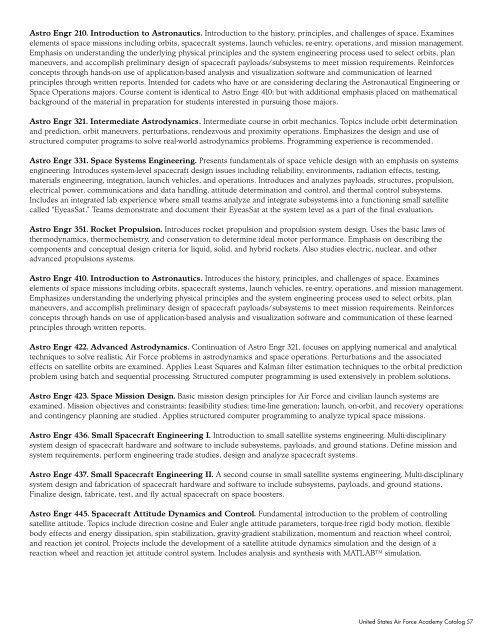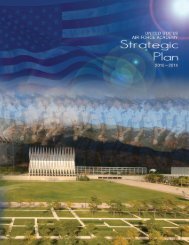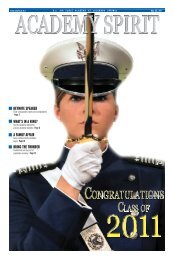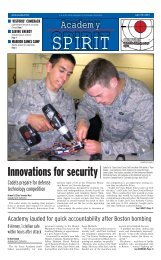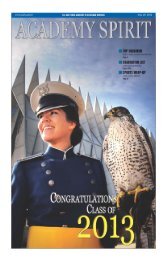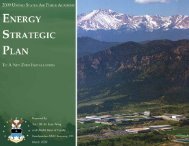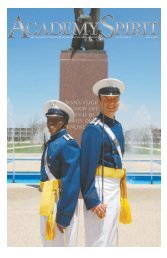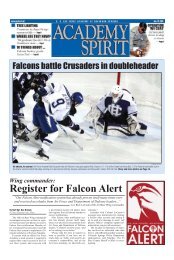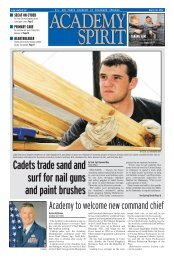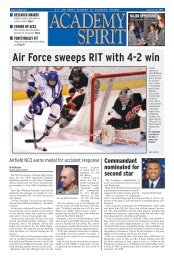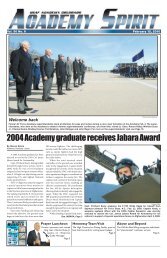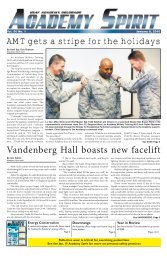2008-2009 Catalog - United States Air Force Academy
2008-2009 Catalog - United States Air Force Academy
2008-2009 Catalog - United States Air Force Academy
You also want an ePaper? Increase the reach of your titles
YUMPU automatically turns print PDFs into web optimized ePapers that Google loves.
Astro Engr 210. Introduction to Astronautics. Introduction to the history, principles, and challenges of space. Examines<br />
elements of space missions including orbits, spacecraft systems, launch vehicles, re-entry, operations, and mission management.<br />
Emphasis on understanding the underlying physical principles and the system engineering process used to select orbits, plan<br />
maneuvers, and accomplish preliminary design of spacecraft payloads/subsystems to meet mission requirements. Reinforces<br />
concepts through hands-on use of application-based analysis and visualization software and communication of learned<br />
principles through written reports. Intended for cadets who have or are considering declaring the Astronautical Engineering or<br />
Space Operations majors. Course content is identical to Astro Engr 410; but with additional emphasis placed on mathematical<br />
background of the material in preparation for students interested in pursuing those majors.<br />
Astro Engr 321. Intermediate Astrodynamics. Intermediate course in orbit mechanics. Topics include orbit determination<br />
and prediction, orbit maneuvers, perturbations, rendezvous and proximity operations. Emphasizes the design and use of<br />
structured computer programs to solve real-world astrodynamics problems. Programming experience is recommended.<br />
Astro Engr 331. Space Systems Engineering. Presents fundamentals of space vehicle design with an emphasis on systems<br />
engineering. Introduces system-level spacecraft design issues including reliability, environments, radiation effects, testing,<br />
materials engineering, integration, launch vehicles, and operations. Introduces and analyzes payloads, structures, propulsion,<br />
electrical power, communications and data handling, attitude determination and control, and thermal control subsystems.<br />
Includes an integrated lab experience where small teams analyze and integrate subsystems into a functioning small satellite<br />
called “EyeasSat.” Teams demonstrate and document their EyeasSat at the system level as a part of the final evaluation.<br />
Astro Engr 351. Rocket Propulsion. Introduces rocket propulsion and propulsion system design. Uses the basic laws of<br />
thermodynamics, thermochemistry, and conservation to determine ideal motor performance. Emphasis on describing the<br />
components and conceptual design criteria for liquid, solid, and hybrid rockets. Also studies electric, nuclear, and other<br />
advanced propulsions systems.<br />
Astro Engr 410. Introduction to Astronautics. Introduces the history, principles, and challenges of space. Examines<br />
elements of space missions including orbits, spacecraft systems, launch vehicles, re-entry, operations, and mission management.<br />
Emphasizes understanding the underlying physical principles and the system engineering process used to select orbits, plan<br />
maneuvers, and accomplish preliminary design of spacecraft payloads/subsystems to meet mission requirements. Reinforces<br />
concepts through hands on use of application-based analysis and visualization software and communication of these learned<br />
principles through written reports.<br />
Astro Engr 422. Advanced Astrodynamics. Continuation of Astro Engr 321, focuses on applying numerical and analytical<br />
techniques to solve realistic <strong>Air</strong> <strong>Force</strong> problems in astrodynamics and space operations. Perturbations and the associated<br />
effects on satellite orbits are examined. Applies Least Squares and Kalman filter estimation techniques to the orbital prediction<br />
problem using batch and sequential processing. Structured computer programming is used extensively in problem solutions.<br />
Astro Engr 423. Space Mission Design. Basic mission design principles for <strong>Air</strong> <strong>Force</strong> and civilian launch systems are<br />
examined. Mission objectives and constraints; feasibility studies; time-line generation; launch, on-orbit, and recovery operations;<br />
and contingency planning are studied. Applies structured computer programming to analyze typical space missions.<br />
Astro Engr 436. Small Spacecraft Engineering I. Introduction to small satellite systems engineering. Multi-disciplinary<br />
system design of spacecraft hardware and software to include subsystems, payloads, and ground stations. Define mission and<br />
system requirements, perform engineering trade studies, design and analyze spacecraft systems.<br />
Astro Engr 437. Small Spacecraft Engineering II. A second course in small satellite systems engineering. Multi-disciplinary<br />
system design and fabrication of spacecraft hardware and software to include subsystems, payloads, and ground stations.<br />
Finalize design, fabricate, test, and fly actual spacecraft on space boosters.<br />
Astro Engr 445. Spacecraft Attitude Dynamics and Control. Fundamental introduction to the problem of controlling<br />
satellite attitude. Topics include direction cosine and Euler angle attitude parameters, torque-free rigid body motion, flexible<br />
body effects and energy dissipation, spin stabilization, gravity-gradient stabilization, momentum and reaction wheel control,<br />
and reaction jet control. Projects include the development of a satellite attitude dynamics simulation and the design of a<br />
reaction wheel and reaction jet attitude control system. Includes analysis and synthesis with MATLAB simulation.<br />
<strong>United</strong> <strong>States</strong> <strong>Air</strong> <strong>Force</strong> <strong>Academy</strong> <strong>Catalog</strong> 57


